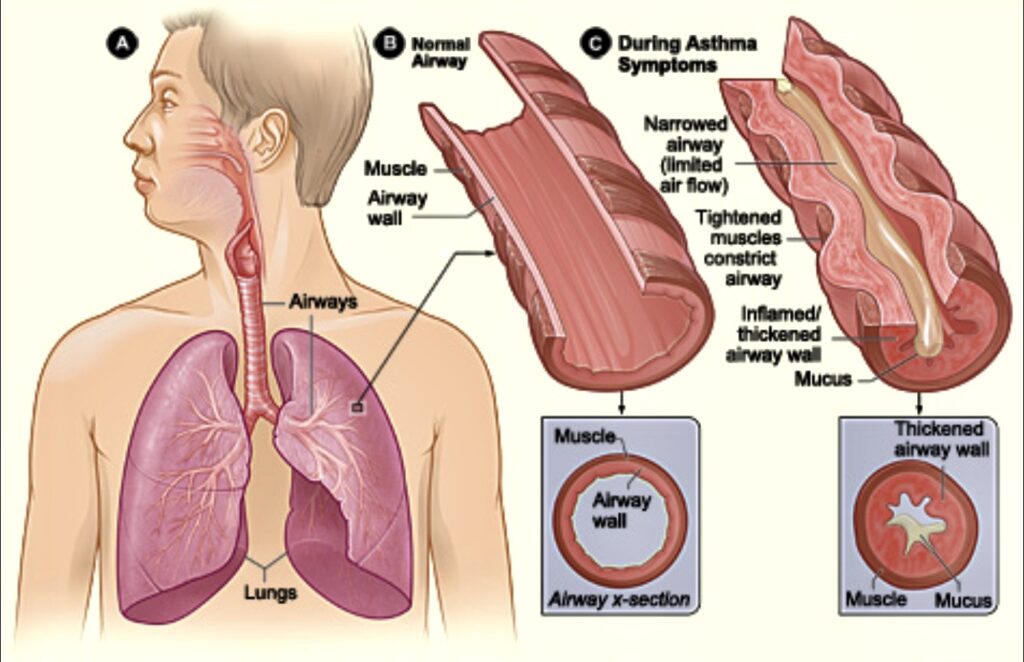By Henrylito D. Tacio
Photos from Wikipedia
HER voice shook as she spoke to her pediatrician at 3:30 that rainy morning. The day before, she noticed a slight tearing in her baby’s eyes and thought perhaps the baby had brushed against her wool sweater. But now, in the predawn hours, her infant was sneezing, coughing, and wheezing.
The couple rushed the baby to the pediatrician’s office that morning and watched tensely as the doctor examined the infant and then administered the necessary medication. In a few days, with repeated doses of the prescription medication, the baby recovered from the frightening incident.
Yet, it was only a few months later that the baby started to wheeze again, suffering from the same symptoms as before: runny nose, tearing eyes, and that tight, gasping wheeze. Again, the couple made an emergency trip to the pediatrician’s office.
“What are we doing wrong?” the husband asked the doctor. “We hardly take our baby out of the house. We follow your suggestions to the letter. Yet, she seems unusually prone to breathing problems.”
The pediatrician, after explaining that some children are more susceptible to respiratory problems than others, asked: “Do either of you have asthma? Have either of you ever been hospitalized with breathing problems? What about the rest of the family – your child’s uncles, aunts, grandparents?”
“To most of the questions, we had to answer yes,” recalled Debra Bruce, author of several books on health issues. “We both had suffered from asthma as children. Bob (her husband) had been hospitalized with the problem when he was in elementary school. Many of our relatives were also plagued with lung problems. I had to admit that my own allergies were under control only on very clear days.”
The couple is lucky; in some parts of the world, asthma is not under control. The 2011 Global Asthma report said that there are now 235 million throughout the world who are suffering from asthma. In the Philippines alone, around 10.7 million people have asthma.
Some studies have shown that thirty-four percent of those with asthma are children aged six to 14. The rest are adults. Asthma has been cited as one of the leading causes of hospitalization and absenteeism from school and work.

“This is alarming, for it means school-children may have their performance in school affected and young adults may lose out on job opportunities and decrease their earning potential due to their ailment. If not treated early, children who are affected with the disease will become disabled,” commented an asthma specialist.
Asthma has become one of the top burdens in terms of medical expenses in the country. In 2011, asthma ranked as the 13th most reimbursed condition for which PhilHealth paid P369 million. A year later, it became the sixth most reimbursed condition.
“Asthma attacks all age groups but often starts in childhood,” points out the Geneva-based World Health Organization (WHO). “It is a disease characterized by recurrent attacks of breathlessness, wheezing (a whistling sound while breathing), and coughing (with or without thick sputum), which vary in severity and frequency from person to person. In an individual, they may occur from hour to hour and day to day.”
Airway obstruction is the most important characteristic of asthma. “The airways of the lungs (the bronchi) are basically tubes with muscular walls,” explains The Merck Manual of Medical Information. “Cells lining the bronchi have microscopic structures, called receptors. These receptors sense the presence of specific substances and stimulate the underlying muscles to contract and relax, thus altering the flow of air.”
Medical authorities say asthma is due to the inflammation of the air passages in the lungs and affects the sensitivity of the nerve endings in the airways, so they become easily irritated. In an attack, the lining of the passages swells, causing the airways to narrow and reducing the flow of air in and out of the lungs.
Risk factors
The strongest risk factors for developing asthma are exposure, especially in infancy, to indoor allergens (such as domestic mites in bedding, carpets and stuffed furniture, cats, and cockroaches) and a family history of asthma or allergy. A study in the South Atlantic Island of Tristan de Cunha, where one in three of the 300 inhabitants has asthma, found children with asthmatic parents were much more likely to develop the condition.
Exposure to tobacco smoke and exposure to chemical irritants in the workplace are additional risk factors. Other risk factors include certain drugs (aspirin and other non-steroid anti-inflammatory drugs), low birth weight, and respiratory infection. The weather (cold air), extreme emotional expression, and physical exercise can exacerbate asthma.
Evidence is mounting that one irritant that can trigger an asthma attack is air pollution, notably vehicle exhaust fumes, smoke from fires, and smokestack emissions. Sufferers are particularly at risk when smog builds up on windless days.
“The easy answer to the rising incidence (of asthma death cases) is the worldwide increase in air pollution,” maintained Dr. Stewart Clarke, head of the department of thoracic medicine at the Royal Free Hospital in London.
Urbanization appears to be activated with an increase in asthma. The nature of the risk is still unclear because studies have not taken into account indoor allergens, although these have been identified as significant risk factors.
“In the under-40 age group, probably 90 percent of asthma is triggered by an allergy,” contends Dr. Willam Ziering, an American allergist. “After 40, it’s about 50 percent. The other 50 percent is triggered by some form of lung disorder such as emphysema.”
What a person puts in his mouth can also cause asthma. “The body’s allergic reaction to a certain food may also trigger asthma,” notes pediatric pulmonologist Dr. Rolando dela Eva. “The most common foods associated with allergies are nuts, poultry and dairy products, fish and shellfish.”
Most asthma cases, however, are genetically inherited. According to Dr. dela Eva, if both parents have asthma, there’s a 50% chance that their children will inherit the disease. The son of an American rock band, Journey’s vocalist, Arnel Pineda, is asthmatic; he inherited it from his father, who discovered he had asthma in 2000.
Treatment
Asthma is a chronic condition that cannot be prevented or cured; however, individual attacks can often be prevented. “Asthma attacks may commonly be prevented if the factors that trigger them are identified and treated or avoided,” the Merck manual states.
There is also an array of drugs that can be used to prevent and treat asthma attacks. “Most of the drugs used to prevent asthma are also used to treat an asthma attack but in higher doses or in different forms,” the Merck manual notes. “Some people need to use more than one drug to prevent and treat their symptoms.”
Medical experts argue that the only way to properly manage asthma is to get a proper diagnosis from a doctor. “You should be prepared to provide your doctor with a complete medical history that includes information about your symptoms,” a physician told an asthmatic. “And you are the one who can provide a lot of that information. So the right diagnosis involves you.”
“The treatment of asthma varies according to the severity of the problem,” writes Drs. Donald M. Vickery and James F. Fries in Take Care of Yourself. “Some people have only one or two episodes of asthma and are never troubled again. Other people will have daily attacks. These severely compromise their ability to function normally.”
Some physicians maintain that children never truly outgrow asthma, but the evidence is otherwise. Drs. Vickery and Fries noted: “More than half of the children diagnosed as having asthma will never have an asthmatic attack as an adult. Another 10 percent will have only occasional attacks during adult life.”
Because asthma is a chronic condition, it usually requires continuous medical care. Patients with moderate to severe asthma have to take long-term medication daily (for example, anti-inflammatory drugs) to control the underlying inflammation and prevent symptoms and attacks. If symptoms occur, short-term medications are used to relieve them.
“Several different prescription drugs are often combined, but we see no reason to begin treatment with such combination drugs,” Drs. Vickery and Fries pointed out. “Many of these compounds have phenobarbital added to counteract some of the stimulating effects of the other medicines included; new medications to counteract the side effects of the previous medication could be added continually.”
“All these drugs are powerful, and all cause side effects,” they warned. “Minimal side effects may be acceptable to relieve major symptoms. If side effects are intolerable, a new treatment can be made. Try to avoid combination drugs.”
Treating attacks
An asthma attack can be frightening — both to the person experiencing it and to others around. “Even when relatively mild, the symptoms provoke anxiety and alarm,” the Merck manual says. “A severe asthma attack is a life-threatening emergency that requires immediate, skilled, professional care. If not treated adequately and quickly, a severe asthma attack can cause death.”
People who have asthma attacks are generally able to treat most attacks without assistance from a health care professional. Typically, they use an inhaler to deliver a dose of a short-acting beta-adrenergic agonist, move into the fresh air (away from cigarette smoke or other irritants), and sit down and rest. Some people may inhale a corticosteroid in addition to a beta-adrenergic agonist.
“An attack usually subsides in 5-10 minutes or that gets worse is likely to require additional treatment supervised by a doctor,” the Merck manual informs.
Famous asthmatics
Unfortunately, because of the stigma associated with asthma, many asthmatics do not take long-term medication to control their condition. “When told of their asthma, many patients do not accept it and will try anything to get rid of it,” laments Dr. Ho Ling, a consultant at the KK Women’s and Children’s Hospital in Singapore.
Unknowingly, asthmatics can participate in athletics. In fact, some Olympic athletes are asthmatics. To name a few: heptathlon champion Jackie Joyner Kersee, wrestler David Schultz and cross country skier Bill Koch. In the 1984 Summer Olympic Games, 11 percent of the American team were asthmatics. In the Philippines, among the famous asthmatics include former basketball player Freddie Webb, basketball star Samboy Lim, and champion swimmer Eric Buhain.
Some of Hollywood stars are also asthmatics. Consider the following: Steve Allen, Loni Anderson, Jason Alexander, Morgan Fairchild, Helen Hayes, Bob Hope, Diane Keaton, Liza Minnelli, Martin Scorcese, Dennis Rodman, Paul Sorvino, Sharon Stone, Elizabeth Taylor, and Orson Welles.
From the past, famous asthmatics include Francis Bacon, Ludwig von Beethoven, Ambrose Bierce, Calvin Coolidge, Charles Dickens, Benjamin Disraeli, Ernesto “Che” Guevera, Oliver Wendell Holmes, John F. Kennedy, Walter Mondale, Marcel Proust, Joseph Pulitzer, Theodore Roosevelt, John Updike, Martin van Buren, Antonio Vivaldi, Edith Wharton, Daniel Webster, Woodrow Wilson, and William IV.
Once an asthmatic, you will always be asthmatic. “If you have chronic asthma, you will have it all the time – even when you feel good,” an asthma specialist declares. “You may not actually experience asthma symptoms every day, but it is a disease that cannot be ignored. Asthma needs to be managed every day.”
Unfortunately, because of the stigma associated with asthma, many asthmatics do not take long-term medication to control their condition. “When told of their asthma, many patients do not accept it and will try anything to get rid of it,” laments Dr. Ho Ling, a consultant at the KK Women’s and Children’s Hospital in Singapore.

